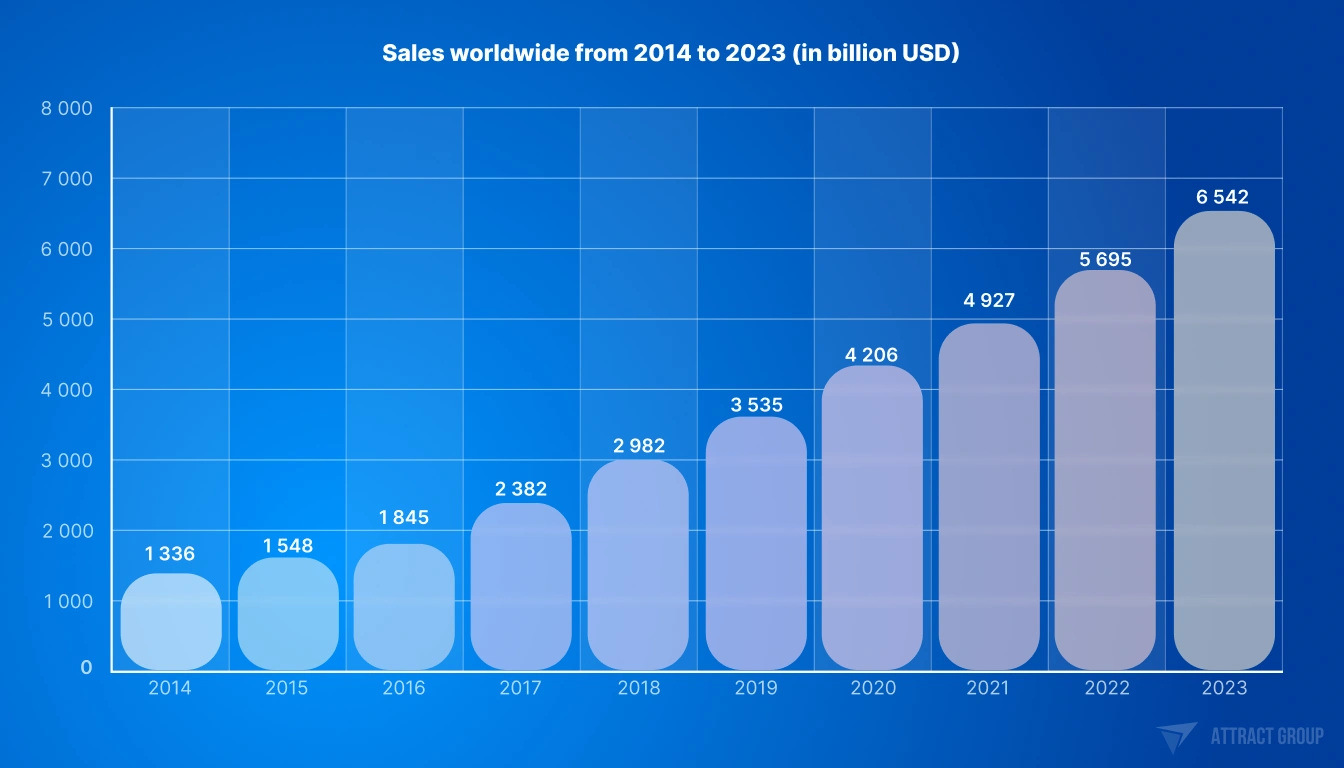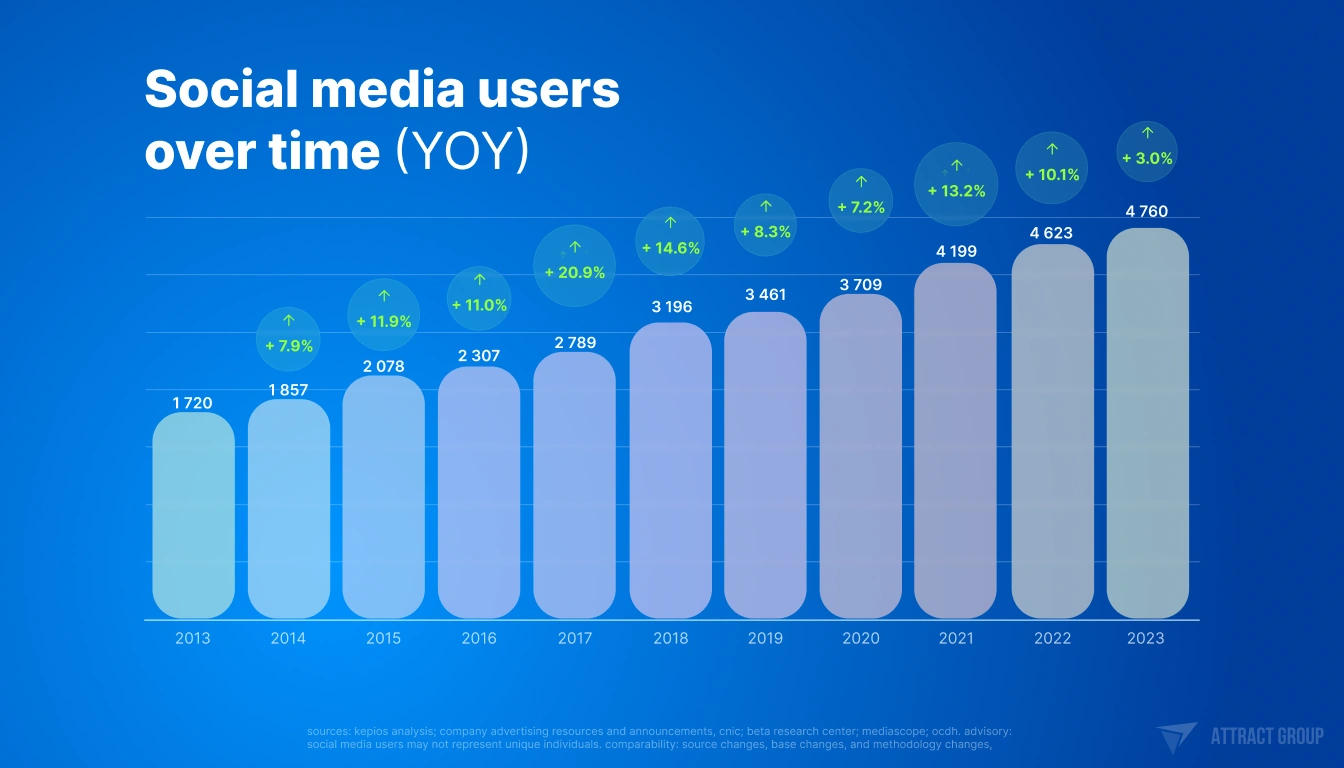E-commerce in the Post-Pandemic World: Trends and Predictions
 21 September 2023
21 September 2023The onset of the global pandemic in 2020 was a game-changer for many sectors, but e-commerce stood out with a staggering growth of 33.6%, reaching an astounding $800 billion. As cities shut down and homes transformed into offices, gyms, and schools, online shopping shifted from being a mere convenience to a crucial lifeline. Fast-forward to 2021, and the trajectory continues to point upward. Even with the world slowly re-emerging and storefronts lighting up again, e-commerce is projected to grow by 13.7% to hit $908 billion.

The provided chart reveals a significant surge in global retail e-commerce sales from 2019 to 2023, showcasing the profound influence of the post-pandemic on online shopping, propelled by pandemic-induced lockdowns.
Stage: E-commerce Before vs. During the Pandemic

Before the Pandemic: The pandemic supercharged the e-commerce sector, pushing regular online shoppers and traditional brick-and-mortar enthusiasts towards digital platforms due to lockdowns and health concerns. While many businesses had to hastily pivot online, the ensuing demand led to innovations in supply chains and the rise of direct-to-consumer models. As physical stores reopened post-pandemic, the blend of online convenience and in-store experience paved the way for a hybrid retail model. Despite the revival of in-person shopping, the embedded e-commerce habits ensured the digital shopping trend’s endurance and evolution.
During the Pandemic: With the onset of the pandemic, this gradual shift turned into an overnight revolution. Physical stores, especially in heavily affected areas, found themselves grappling with reduced footfalls, supply chain disruptions, and strict health protocols. In contrast, e-commerce platforms saw an influx of first-time online shoppers. The very definition of ‘essential’ expanded to include work-from-home equipment, indoor entertainment, and wellness products, among others. Digital transformation, once a strategy for the future, became an urgent necessity. Businesses that had never considered e-commerce found themselves establishing online storefronts, and traditional supply chains underwent rapid digital overhauls. The increase in online shopping during the pandemic wasn’t just a short-term change. It showed a bigger, lasting change in our shopping and living habits.
From Discovery to SEO results, we’ve got you covered.
Pandemic impact on E-commerce: Where are we now

Do you know where we stand in the e-commerce landscape after the pandemic’s upheaval?
The onset of COVID-19, recognized as a global pandemic almost three years ago by the World Health Organization, drastically shifted our daily routines, driving us deeper into the digital realm. With many of us confined to our homes during multiple lockdowns, online shopping became more than a convenience—it became essential. This led to a dramatic increase in global e-commerce sales, reaching heights that were previously thought to be years away.
The post-pandemic e-commerce landscape has been shaped by evolving consumer preferences, technological innovations, and a renewed emphasis on trust and sustainability. For businesses, understanding these shifts and adapting accordingly isn’t just beneficial—it’s essential for staying relevant in this new digital era.
But it’s not just about numbers. The e-commerce boom brought with it profound changes:
Evolution of Consumer Behavior
The pandemic pushed people to adapt to online shopping at an unprecedented scale. Many, who once preferred in-store experiences, found themselves browsing and purchasing online. Now, even with the easing of restrictions, a significant portion of consumers have integrated online shopping into their routines. This behavioral change signifies a long-term shift rather than a temporary reaction.
Surge in New Digital Platforms
When physical stores had to close because of lockdowns, many businesses quickly set up or improved their online stores. This meant more online shopping websites, easier ways to pay online, and new ways to get products delivered to customers.
Supply Chain Changes
One of the most noticeable impacts was felt in the supply chain. Disruptions caused businesses to rethink and often overhaul their supply chain strategies. Many businesses are now focusing on diversifying their suppliers, localizing certain supply chain segments, and investing in real-time tracking systems to enhance resilience.
Elevated Importance of Digital Trust
More people started shopping online, so trust became really important. Shoppers care about their data being safe, paying securely, and getting real products. So, businesses are working hard to make sure everything’s safe and honest to win their trust.
Hybrid Shopping Models
Shopping now mixes online and in-store experiences. People can order items online and collect them at a store. Some websites even let you virtually “try on” items or see them in 3D before buying. This new way of shopping combines the best of both worlds.
Emphasis on Sustainable E-commerce
The pandemic also heightened awareness of sustainability. Consumers are now more inclined towards brands that demonstrate environmental responsibility. This has led to a rise in sustainable packaging, carbon-neutral deliveries, and platforms highlighting eco-friendly products.
Top 5 standout e-commerce trends of 2023 and 2024

In 2023, e-commerce has evolved significantly. More people shop online using mobile devices, prioritizing convenience and fast shipping. Virtual try-on tools and personalized shopping experiences, driven by artificial intelligence, have become common. Sustainable and eco-friendly shopping options are also on the rise, with consumers more conscious of their purchasing impacts. Lastly, local and small businesses are leveraging online platforms more, offering unique products and building loyal customer bases. With these emerging trends, e-commerce is set to offer richer and more engaging experiences to customers, combining technology, personalization, and values.
Let’s take a look at the top 5 e-commerce trends for 2023 and 2024:
Trend # 1: Virtual Reality Shopping:
In the evolving landscape of e-commerce, technology is reshaping the way we shop. Imagine being able to “try on” a pair of glasses or see how a new sofa would look in your living room without leaving your home. This is made possible by Virtual Reality (VR) and Augmented Reality (AR) technologies. Almost half of marketers are gearing up to integrate this tech into their platforms by 2023. The allure? It offers customers a more realistic view of what they’re purchasing, which means they’re happier with their choices and less likely to return products.
Trend # 2: Voice-Assisted Shopping:
Remember when we’d just use voice assistants to play our favorite tunes? Times are changing. Now, we’re asking Alexa or Google Assistant to help us with our shopping. With a quick voice command, you can have your shopping needs sorted. The popularity of voice search is undeniable. By 2024, 25% of consumers plan to frequently utilize voice commands for their shopping needs, signifying a growing trust in this technology.
Trend # 3: Sustainability Matters:
Today’s consumer is conscious and cares deeply about the planet’s well-being. Brands that prioritize sustainability, be it through eco-friendly packaging, ethical sourcing, or other green initiatives, are earning brownie points. With increasing awareness about climate change and environmental issues, customers are actively seeking out brands that echo their values. Supporting a brand becomes more than just a purchase; it’s a statement about what it stands for.
Trend # 4: Livestream Shopping:
The blend of entertainment and shopping is a winning combo. Livestream shopping offers just that. Influencers and brands are going live, demonstrating products in real time, and viewers have the chance to ask questions, get instant feedback, and make on-the-spot purchases. It’s projected that almost 50% of consumers will engage with shopping live streams in 2024. It’s interactive, and fun, and gives a new twist to the conventional shopping experience.
Trend # 5: Chats Lead to Buys:
Conversation is powerful, especially when it leads to sales. Chatbots and messenger apps are bridging the gap between brands and consumers, offering a platform for queries, feedback, and purchases. It’s personal, instantaneous, and efficient. With 26% of marketers focusing on conversational marketing in 2023, it’s evident that the trend is not just a passing phase but a mainstay in the e-commerce domain.
Predictions for the Future of E-commerce

It looks like e-commerce is only going to get bigger and better. We can expect augmented and virtual reality to be a major part of online shopping, meaning we’ll be able to see what products look like before we buy them. Algorithms will make sure we get personalized recommendations, and the payment and checkout processes will be smoother and more secure with biometric authentication. Plus, with more focus on the environment, we should get more sustainable options for packaging and delivery.
The top e-commerce experts have reflected on how the digital marketplace has adapted and changed in response to worldwide issues. They’ve pointed out how digital platforms have stayed resilient during these difficult times, showing how quickly people have adopted digital technology, how vital flexibility in supply chains is, and how customers now expect more from their user experiences. These experts have also put an emphasis on sustainability, local services, and multi-channel approaches. In looking back at the role the pandemic has played and looking forward to what’s next, these professionals have provided insight into the future of e-commerce and the strategies businesses should use to stay ahead.
Here are the top 5 predictions for the future landscape of e-commerce:
Top 5 predictions for future
- Augmented reality in the shopping experience
With the latest tech in AR and VR, and with big companies like Facebook diving into the Metaverse, shopping is getting a cool upgrade. Think about it: Businesses using this tech will let customers “try on” clothes virtually. Plus, you could shop online with friends from anywhere!
- Social media Shopping
Social media shopping will be booming in the future. Platforms like Instagram elevate an e-commerce venture to the new horizon. When paired with influencer marketing, social media shopping transforms into a potent strategy for attracting customers and boosting brand visibility.
Datareportal showed that social media followers are on the rise every year:

- Payment Innovations in E-commerce: Navigating the Cryptocurrency Wave
In the ever-evolving world of e-commerce, staying updated with the latest trends is crucial. One area seeing significant transformation is the payment sector. As the digital realm expands, e-commerce platforms are actively embracing newer payment methods, with cryptocurrencies leading the charge.
- Subscription Models
In the dynamic e-commerce landscape, businesses are constantly searching for ways to nurture lasting relationships with their customers. One key trend emerging is the shift towards subscription-based models. By offering regular product deliveries, companies can provide a personalized experience, fostering stronger loyalty among their customer base. This not only translates to more consistent revenue streams but also deepens customer engagement.
- Direct-to-Consumer (D2C) Model Growth
In the evolving post-pandemic e-commerce realm, the Direct-to-Consumer (D2C) It’s a retail method where brands sell directly to customers, skipping the middlemen and big stores. This model is gaining traction. This approach eliminates traditional middlemen, allowing brands to sell directly to consumers. This not only offers shoppers personalized experiences and better prices but also enables brands to control their messaging and utilize immediate customer feedback.
Conclusion
E-commerce has truly reinvented itself in the past year. From personal touches to being kinder to our planet, it’s clear that e-commerce isn’t just a temporary fix—it’s the way forward. For businesses and shoppers alike, understanding these shifts will be key. As we navigate this digital age, the future promises more innovation, convenience, and connection for all.
Some images presented in this article made by www.freepik.com










